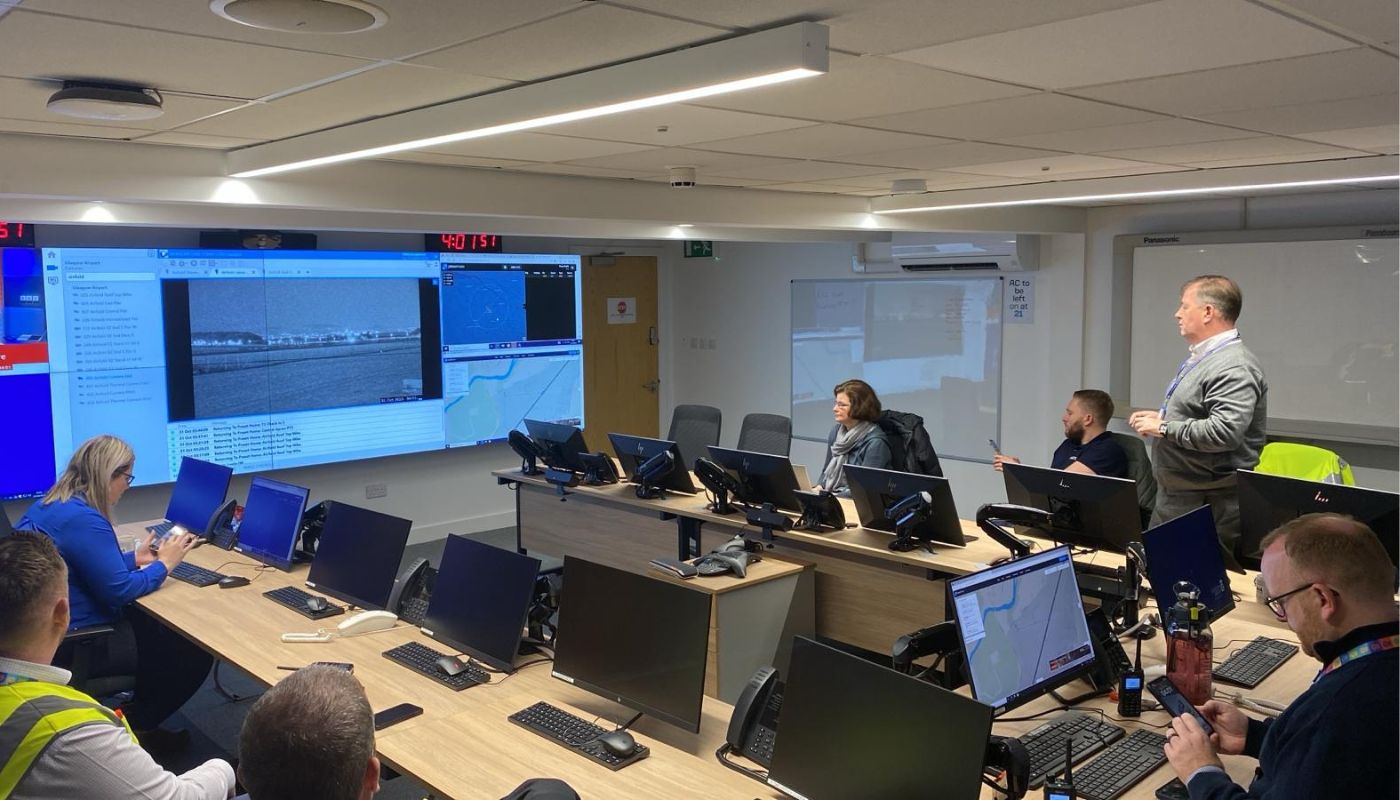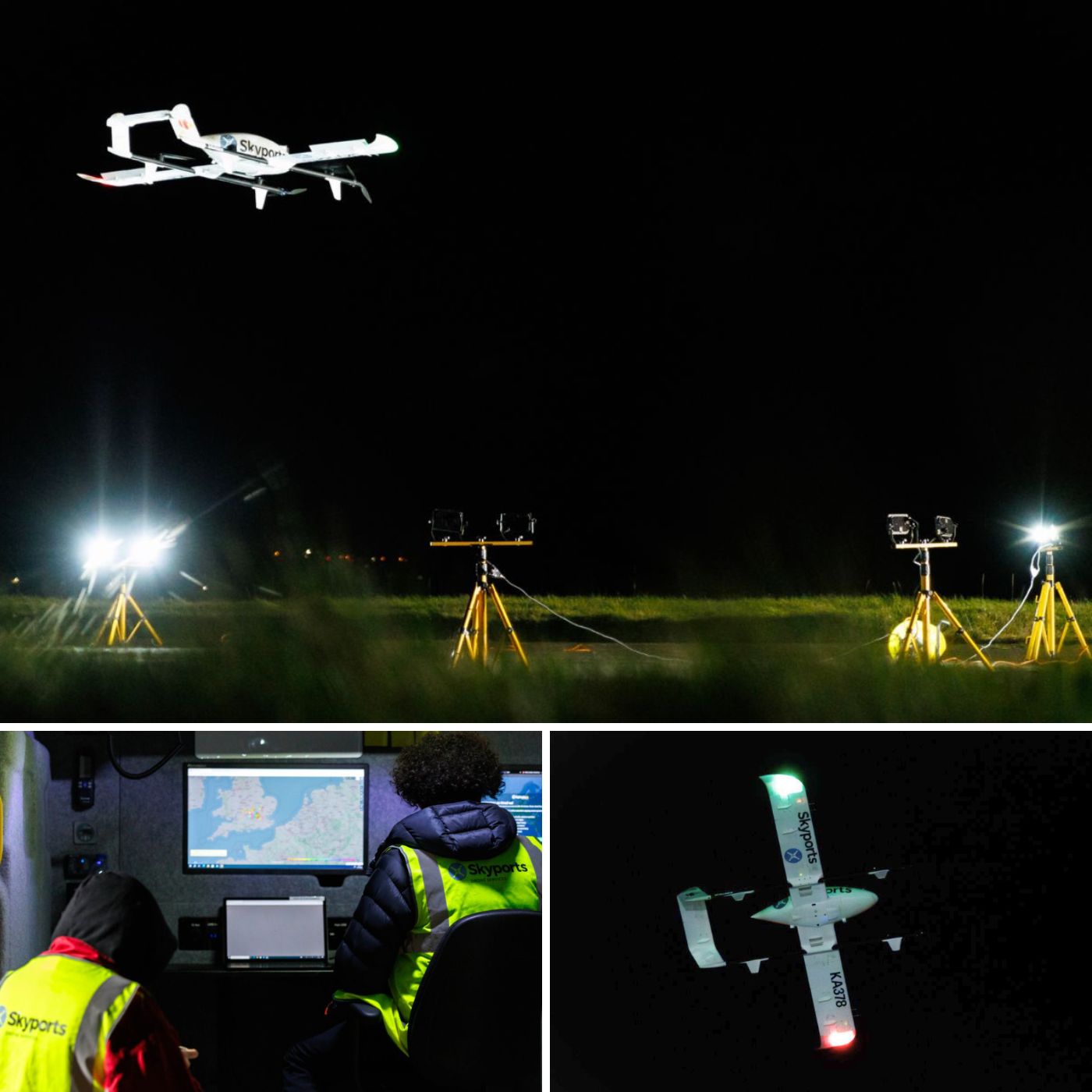In November the first drone flight from Glasgow Airport flew the short distance to Golden Jubilee Hospital. Why this small journey is so important is that the flight took place in controlled airspace alongside traditional aviation, with NATS providing the airspace management that is so critical to enabling integration for all airspace users. It was a step further along an ever-quickening path to open up the skies for new and uncrewed aircraft.

Mission Control for the Glasgow Airport trial flight
“On average, the time it takes blood tests to get to a lab from rural areas is 20 hours,” says Alex. “With a drone it can take less than an hour which could mean a quicker diagnosis and earlier treatment. Expanding on projects like this on a larger scale can have huge, positive impacts for society.”
With a drone it can take less than an hour which could mean a quicker diagnosis and earlier treatment. Expanding on projects like this on a larger scale can have huge, positive impacts for society.
Making it possible
And he suggests that safe integration can be advanced through trialling three measures in different airspaces: technology, airspace management and risk assessments.
In the UK, NATS and the UK CAA are collaborating on an approach that’s a combination of both airspace management and detect and avoid technology, with work ongoing to determine how to enable these services at scale. It’s also an approach NATS is working on with partners around the world where there is growing demand to understand how to integrate drones - and eVTOLs - into existing areas of busy airspace.
“We have been working closely with NATS and the UK CAA to trial different airspace and create processes and procedures. Technology plays a big part and we are looking at solutions such as detect and avoid sensors that pick up when someone is in a certain airspace and then automatically avoid them,” he says.

“Another method is through airspace management and agreeing that everyone can use a certain airspace as long as they have a transponder or beacon so that all aircraft can be seen clearly and avoided.
"In Singapore, where we conduct inspection work on ships, we plug into a central uncrewed traffic management system where drone operators and regulators are connected and can see each other.
“Lastly, often a stringent risk assessment may be all that is needed in locations with less aviation. We operate off the southern coast of South Korea, for example, and there is no general air traffic other than helicopters with whom we have very specific agreements that when they’re flying, we’re not – it’s a very safe system that’s approved by the regulator.”
We have been working closely with NATS and the UK CAA to trial different airspace and create processes and procedures
Life-saving solutions
Healthcare is another of Skyports Drone Services’ key use cases. Since 2021, the company has been working with the NHS to deliver medicine, pathology and blood samples to medical facilities, a project that began during Covid and was initially concentrated in the Argyll and Bute region in western Scotland.
Elsewhere in Scotland, Skyports Drone Services is also part of Project Caelus, a consortium of 16 partners including NATS providing airspace management and integration expertise and NHS Scotland, that are delivering the first national drone network that can transport essential medicines, blood and other medical supplies throughout Scotland including to remote communities.
Project Caelus is part of the Future Flight Challenge, a £300m UK government-funded programme to advance airspace management and build an aviation ecosystem for the future that is fit for all.
While this project is concentrated around Scotland, the learnings from it will advance drone delivery and airspace management globally.
In November 2023, the first flights were underway from Glasgow Airport to Golden Jubilee Hospital. Skyports Drone Services is working closely with NATS and AGS, the owner of Glasgow Airport, to open up airspace both within controlled and uncontrolled airspace to allow for drone deliveries.

“NATS obviously has a very good understanding of airspace,” says Alex. “We have been working closely with them and the UK CAA to trial different airspace and create processes and procedures, such as transponder mandatory zones on blocks of airspace where both drones and crewed aircraft can communicate with each other and operate together.”
Skyports Drone Services is also a key member of the BVLOS Operations Forum, organised by NATS, with more than 20 organisations that are the leading edge of BVLOS drone operations in the UK.
The forum consolidates industry’s view on BVLOS and then works closely with the regulators to find solutions. “Forums like this one are crucial because without them the industry risks operating in a piecemeal approach and getting nowhere,” adds Alex.

The future of uncrewed aviation is exciting, and the potential uses of different drones are clear. But to ensure that flight paths stay clear too, close collaboration between organisations like Skyports, NATS and regulators needs to continue. Airspace integration is going to be absolutely vital to helping the industry to scale and grow.
“We are heading in the right direction together,” says Alex. “There is demand for our services and we are looking forward to exploring how our flights can benefit society even further as we cover more airspace.”
We are looking forward to exploring how our flights can benefit society even further...